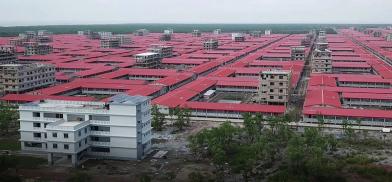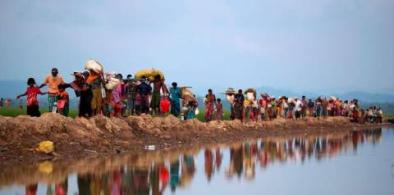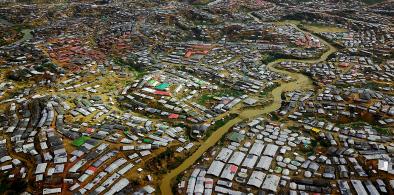The Rohingya refugee dilemma: Does a sustainable solution lie in their integration into Bangladesh?
While the Rohingya issue remains complex and multi-faceted, the potential for the coming generations to integrate into Bangladesh seems natural and realistic. As we move into a seventh year since their major influx, it's evident that repatriation efforts have made limited headway.

The Rohingya Genocide Day on August 25 serves as a poignant reminder of their journey and the adversities they've faced, including the tragic death of figures like Mohib Ullah and calamities such as fires and the move to Bhasan Char. Each year intensifies the global responsibility to act. With the world watching, the pivotal question remains: Could integration within Bangladesh be the answer the Rohingya have been waiting for?
Since 1978, Rohingya refugees have experienced displacements, with Cox's Bazar in Bangladesh witnessing a major influx of over 711,364 refugees primarily in 2017 (UNHCR). This makes the Rohingya one of the world's largest refugee groups. As their situation draws global attention, the complexities surrounding their plight persist.
Resilience defines the Rohingya's daily existence in Cox's Bazar. Essential needs such as food, water, shelter, and healthcare remain in shortage. Despite the challenges, their strong cultural identity stands as both a shield against adversity and, paradoxically, a reason for their persecution. Myanmar's refusal to grant them citizenship further underscores their vulnerable state, making their return perilous. Bangladesh, with its intrinsic challenges, has been bearing the weight of this prolonged situation, categorized by the UNHCR. The extended nature of this displacement leads to concerns of escalating deterioration in living conditions, potential for exploitation, and the mounting stress on a nation like Bangladesh.
Safety concerns shadow repatriation
However, solutions are within reach. Alongside addressing immediate needs, there's an urgent call to devise strategies focusing on repatriation, resettlement, and local assimilation. Moreover, diplomatic initiatives must prioritize the restoration of peace in Myanmar, aiming to create an environment conducive to the Rohingya's safe return.
In a recent acknowledgment of Bangladesh's efforts, Uzra Zeya, the US Under Secretary for Civilian Security, Democracy, and Human Rights, commended the nation. She highlighted that, since August 2017, the US contributed over $2.1 billion to aid the humanitarian efforts, with a recent commitment of $74 million, encouraging other nations to follow suit.
However, Bangladesh's Foreign Minister AK Abdul Momen clarified on August 16, 2023, that a permanent solution for the Rohingya in Bangladesh needs to be foreseen. Citing the nation's population challenges, he urged global players, especially the US, to promote their return to Myanmar, emphasizing repatriation as the primary objective.
The historical precedent indicates that repatriation often transpires during significant political shifts in the refugees' homeland. Yet, for the Rohingya, safety concerns in Myanmar, especially with the Rakhine Buddhists, pose a barrier to such attempts.
Future lies in integration?
Cox's Bazar presents unique opportunities for the Rohingya in terms of work, language assimilation, education, and societal integration. Over time, some might embrace Bangladesh as home, given the challenges in Rakhine. The path toward integration in Bangladesh has challenges, but it's a future that might be the most realistic for the Rohingya. It has been seven years with very little repatriation of the refugees to their homeland.
First and foremost, there's a need to address socio-economic aspects. Employment opportunities tailored to the skill set of the Rohingya can not only help in their economic upliftment but also foster a sense of belonging. Specialized vocational training programs, designed with local needs in mind, can serve as a bridge to integrate them into the workforce.
Language serves as a vital tool for assimilation. While many Rohingya are already conversant in Bengali due to the linguistic similarities with their native Chittagonian, formal language programs can help them integrate more seamlessly into local communities. This linguistic integration would be pivotal for them to access education, healthcare, and other public services more effectively.
Education, especially for the younger generation of Rohingya, is crucial. Inclusion in local schools, coupled with supplementary education to bridge any learning gaps, will ensure they grow up feeling a part of the community they live in.
Moreover, cultural exchange programs can help in fostering mutual respect and understanding. Celebrating Rohingya festivals alongside local ones, organizing community dialogues, and creating platforms where both communities can share their stories and traditions can work wonders.
While the Rohingya issue remains complex and multi-faceted, the potential for the coming generations to integrate into Bangladesh seems natural and realistic. As we mark seven years since their major influx, it's evident that repatriation efforts have made limited headway. With each passing year, the call to weave the Rohingya into the socio-cultural fabric of Bangladesh becomes more pressing. For the Rohingya, who have faced countless adversities, integration might not just be a humanitarian success story but also a pragmatic and lasting solution to their prolonged displacement.
(The author is a Bangkok-based Bangladeshi researcher who works on the subject of refugee migration and rehabilitation. Views are personal. He can be contacted at safenroy@gmail.com)
















Post a Comment